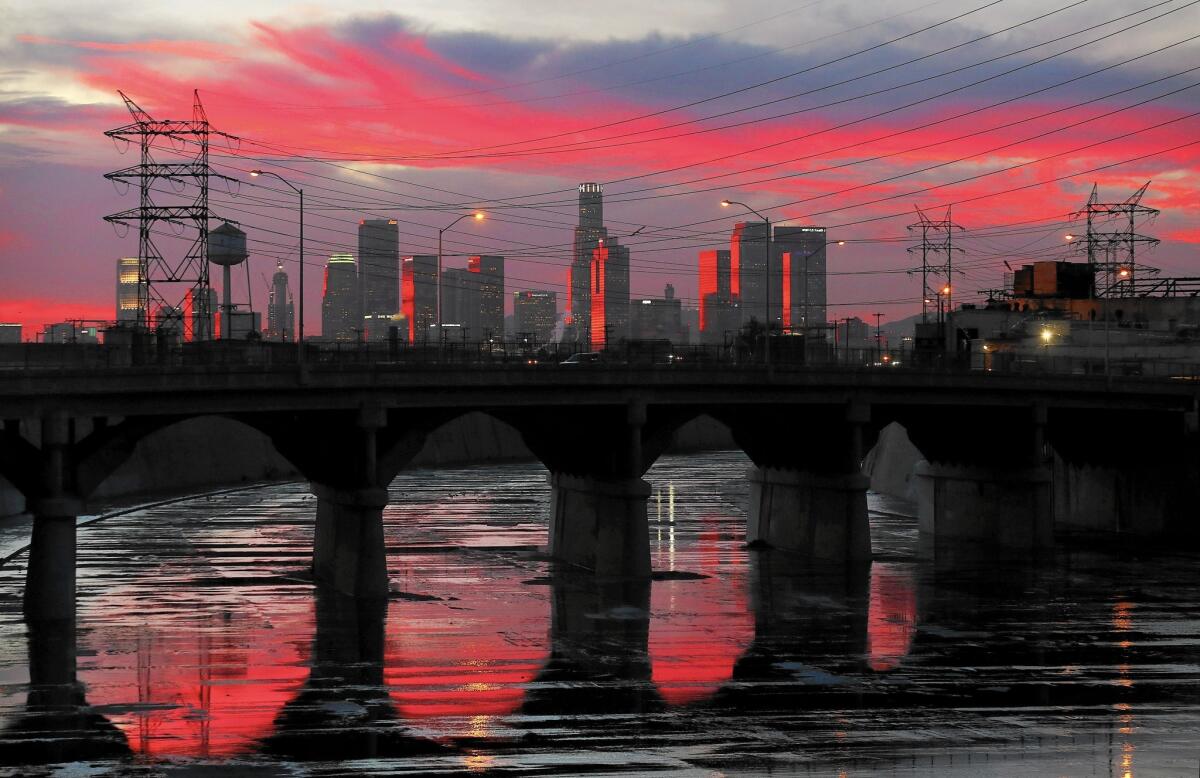Frank Gehry faces monumental challenge in L.A. River project

Members of Congress from the Los Angeles area are asking for federal funding to help with a plan to revive the Los Angeles River.
Cutting through a region whose wildly different parts don’t always seem to add up to a cohesive whole, the Los Angeles River reflects the neighborhoods through which it runs: Shaded and bucolic in the San Fernando Valley, a concrete gulch teeming with graffiti near the rail yards east of downtown.
Architect Frank Gehry says that he wants to remake this largely derelict waterway with a unifying vision.
But as the early contours of Gehry’s plans for the river emerged Friday, so did the challenges that his team of architects and engineers will face in crafting what they say would be “a continuous experience” over 51 miles of a waterway that flows through 15 cities and a varied landscape of parks, residential neighborhoods, urban centers and bleak stretches of industrial land.
The first public unveiling of the plans by partners in Gehry’s firm lacked detail but hinted at a public works project of historic ambition. Clusters along the river would be set aside for parkland and new real estate development, as well as bike and pedestrian paths under a unified (though still undefined) design theme. The river, along with some of its tributaries, would be re-engineered to improve the reclamation of runoff water.
“The opportunity to work on a complicated piece of infrastructure like the L.A. River is a once-in-a-lifetime opportunity,” Gehry, who did not attend the Friday briefing with reporters because he was recovering from back surgery, said in a statement. “Los Angeles is my home and I’ve never seen a greater need than now to explore how our existing infrastructure may be used in more ways than intended.”
Anand Devarajan of Gehry Partners LLP said the project seeks to answer a basic question about one of the Los Angeles Basin’s most recognizable landmarks: “What is the identity of the river?” The range of complex and sometimes contradictory answers to that query are likely to define public reception of Gehry’s still-evolving vision, which has already drawn criticism as a top-down branding of a regional resource by a celebrity architect.
Part of the challenge lies in navigating the thicket of city, county, state and federal regulations that govern alterations to the waterway. “There are going to be a lot of agencies at all levels — city, state, federal — that are going to have an interest in this plan and want to weigh in,” said Damon Nagami, a senior attorney for the Natural Resources Defense Council.
Just as problematic, some predict, could be building political consensus for such a far-reaching development concept in a region where fractious interest groups and fiercely autonomous local governments often have competing priorities.
“The number of different jurisdictions that the river touches upon during its 51-mile course presents challenges to developing a coordinated vision, especially considering the numbers of private property owners,” said Jonathan Nettler of the Urban Land Institute’s Los Angeles District Council.
Gehry’s interest in the river has already provoked some high-profile opposition. Lewis MacAdams, co-founder and president of the long-standing environmental activist group Friends of the Los Angeles River, has called Gehry’s vision “the epitome of wrong-ended planning.”
He declined to comment on Friday’s presentation, but his organization has so far refused to endorse the architect’s involvement.
The river has inspired other grand visions. Gehry’s architects noted that Long Beach, Los Angeles County, the city of Los Angeles and the U.S. Army Corps of Engineers have all drafted blueprints for riverfront development.
“There are a lot of master plans that have been done in the last 20 to 25 years,” said Tensho Takemori, a Gehry partner who helped conduct Friday’s media briefing. “We’ve read all of this information, but none of it’s correlated.” He acknowledged that the disparate perspectives on the river’s future “could become a big obstacle in terms of creating a centralized conversation.”
One of Gehry’s objectives, he said, is to gather the information from predecessor plans before settling on a path forward.
What that path will look like is largely unclear. Takemori said no renderings have been prepared.
So far, Gehry’s architects and engineers have only surveyed the river and worked on a detailed, three-dimensional landscape model of the kind Gehry insists on creating before beginning work on buildings and master plans.
Takemori said he could understand public frustration at knowing big changes could be on the way for the river, but having no idea what the changes might look like.
“It’s really hard at this point,” he said. “People are struggling because they think of our office as producing images.”
Preliminary maps displayed Friday included proposed zones of development and parkland spaced along the river as it winds from Canoga Canyon to the Long Beach waterfront. Some of the potential development zones include the area east of the river’s origin in Canoga Park; in the Elysian Valley and downtown areas of Los Angeles and in Long Beach.
Takemori emphasized that the maps were abstract and said Gehry has not yet sketched out precise locations for projects.
“It’s meant to be a concept,” he said.
Omar Brownson of the L.A. River Revitalization Corp., the city-affiliated nonprofit that commissioned Gehry, said the next step will be resolving the “Gordian knot” of allowing greater public access in and around the river without jeopardizing safety at times of heavy rain.
The river runs at a trickle most of the year, especially during extended dry spells such as California’s current drought.
But it is periodically engorged with fast-moving storm water. Indeed, the waterway was encased in concrete in the mid-20th century to move water quickly to the sea and prevent flooding.
Brownson also said the River Corp. is trying to arrange public and private funding to pay for the next phase of work by Gehry’s firm, which he said would take three to six months and cost “a couple million” dollars.
He declined to say whom the group is pursuing for money in the private sector.
Devarajan said the project will involve extensive public input and allow for individuality in the different neighborhoods along the river’s course.
“It requires each community that’s touching the river to really define how they want to engage the river,” Devarajan said.
“This is their backyard,” he said.
Follow @PeteJamison on Twitter for news from L.A. City Hall
ALSO:
Is the drought killing California’s giant sequoias?
Watch thousands of tiny red crabs invade Channel Islands
How the drought has affected San Francisco’s devastating lack of public restrooms
More to Read
Sign up for Essential California
The most important California stories and recommendations in your inbox every morning.
You may occasionally receive promotional content from the Los Angeles Times.











